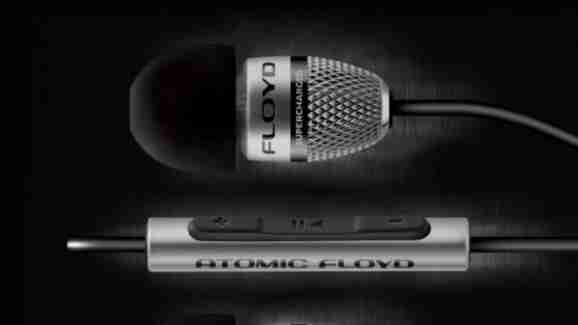Earphones and sunglasses don’t have a great deal in common, but for me they do have one shared trait: They’re both indispensible accessories that I’m generally averse to spending a lot of money on.

This goes against the grain of my general philosophy of buying the best things within my budget for items that I use a lot. But some things are just more prone to getting lost, dropped, forgotten or smashed to smithereens than others. So why waste a lot of money on them, right?
That said, with a good pair of earphones, you do notice a marked improvement in the audio, which is why I do have a decent set of Sol Republic headphones for use exclusively at home. But for anything involving the outdoors, I’ll normally use a 20 bucks set of wrap-arounds or in-ear incarnations that I don’t mind scrunching up in my pocket when the occasion requires it.
But not everyone is the same. Atomic Floyd has built a solid reputation in recent years as a purveyor of fine earphones. The latest from its vaults are the SuperDarts Titanium +Remote , a premium product that will set you back a cool €300/£250. The US launch will be happening soon too.
It’s worth noting here that these earphones have very much been built with iOS in mind, as they’re more than a simple set of earphones. They also let you answer/hang-up calls on your iPhone, while skipping tracks and changing the volume on any app. Over on Android, they will of course still work as ordinary earphones, but the remote’s functionality is very much hit-or-miss depending on the app you’re seeking to control, and the device you’re using.
At any rate, here’s a quick look at how much bang you get for your buck.
Packed into a neat, solid box you’ll find the Atomic Floyd earphones (naturally), 3 different sizes of ear-tips, two adapters for different audio sockets, and a little rubber case.
To look at, the most obvious difference to lower-end earphones is the titanium acoustic chamber and remote control. There is also a gold-plated steel plug, and a Kevlar cable sleeve on the lower portion of the headphone cable.
The latest Atomic Floyds feel like a very solid build, but for €300, the sound is really what you’re concerned about, right? Well we are pleased to say that the audio is pretty darn good, with well-pronounced bass that doesn’t smack you in the face, while it handles treble just as impressively at the other end of the scale too. That said, while they do offer fantastic sound quality, with lower-bitrate tracks you will notice the reduced quality more than you perhaps would with cheaper incarnations.
One issue I experienced was that they constantly fell out my ears. I tried the various sizes of ear-tips, and even the best-fitting ones were still prone to popping out – particularly when played loudly with bassy tracks. If forking out a few hundred bucks for these, you’d maybe want to consider investing in some custom-moulded tips to fit your ears a little more neatly.
The long and short of all this is that the SuperDarts Titanium +Remote look and sound awesome – the titanium build should ensure they last longer than you’re average in-ear contraptions too. But for €300 or your local currency equivalent, these will be for serious audiophiles only.
If that is you, then you can snap up these new puppies from the Atomic Floyd website or Apple Store now.
➤ SuperDarts Titanium +Remote [ Atomic Floyd Website | Apple Store ]
Gartner: Chromebook sales will grow 79% to 5.2 million units in 2014, but ‘will remain a niche market’
Chromebooks are expected to reach 5.2 million units in 2014, a 79 percent increase from 2013, according to Gartner. While the growth is certainly notable, the overall figures aren’t impressive just yet.

The sales shouldn’t be too surprising, as more and more vendors are launching Chromebooks (in fact, Acer today unveiled the first to sport Nvidia’s Tegra K1 processor ).
Yet Chromebooks are still mainly an education sector affair. Gartner estimates nearly 85 percent of Chromebook sales in 2013 were sold to schools, with 82 percent overall being sold in North America.
Samsung and Acer were the first vendors to sell Chromebooks in 2011, and so it should be no surprise they were the two dominant leaders in the market in 2013:
Research firms like Gartner and IDC also like to make predictions a few years into the future, but they’re rarely ever on target. For example, Gartner claims that by 2017, sales of Chromebooks will “nearly triple” to reach 14.4 million units. Furthermore, the firm predicts “Chromebooks will remain a niche market during the next five years.”
Not only is it completely ridiculous to predict sales figures five years down the road, but it’s also laughable to declare how an operating system will fare overall. We have no idea what Google has in store for Chrome OS. The company could drop it completely in 2015, or could push it as a core of its computing strategy going forward. After all, it’s already testing Android apps on Chromebooks , a strategy that has a lot of potential.
Gartner also offers some “advice” to OEMs selling Chromebooks:
No shit.
Top Image Credit: Kevin Jarrett/Flickr
CAMpanion Kickstarter project targets GoPro users outside of extreme sports
Let’s say you’re not an extreme sports nut, but you envision a wider potential for using the handy GoPro sports action videocam than recording yourself skydiving or skiing down a treacherous slope.

A new product in the making called CAMpanion , which launched today on Kickstarter for a 60-day campaign to raise $28,000, is a smartphone hardware add-on that lets you use your GoPro for an array of commonplace activities and everyday shooting situations — just like you’d use a point and shoot camera or your smartphone.
CAMpanion, which is designed to work with GoPro 3, 3+ and 4 , attaches to your smartphone or tablet. From there you can view a scene through the lens and shoot using both front and rear cameras.
According to the FAQ, “We hope to become a standard accessory of the GoPro user. We could definitely spend hours surfing the GoPro channel on YouTube enjoying the crazy and intense footage people are making with their GoPros, but we know that this camera has a lot to offer in everyday settings too, and we hope to help people take advantage of that potential.”
The device fastens to your camera using VHB adhesive and includes a mounting plate and two GoPro mounts to accommodate the different camera models. The exposed GoPro CAMpanion is used with a GoPro outside of its protective case. It wraps around the videocam and slides onto the CAMpanion mounting plate.
The housing CAMpanion is designed for cameras inside the protective enclosure. It has a plate that connects to the back of the protective case using the double-sided adhesive. This plate slides and locks onto the mounting plate. Both CAMpanions are included in the kit, which also includes a rubber lens cap with a drawing of what looks like a Husky dog to use on your GoPro.
When you have the unit mounted to your smartphone, the whole thing is small enough to fit in your pocket.
You can use your smartphone flashlight to light up the shot, or attach additional lighting (or other accessories) to your CAMpanion’s cold shoe mount.
It should take about 15 to 45 days from the end of the Kickstarter campaign until backers have their CAMpanions in hand. You can also purchase a special 3D printable file (STL) of the CAMpanion for $5. This basic file is designed for GoPro enthusiasts who have 3D printers and can’t wait for the CAMpanion delivery.
➤ CAMpanion
